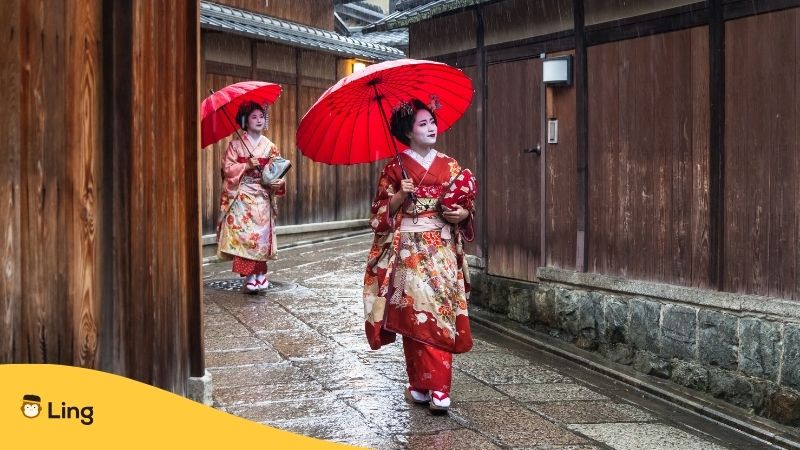Kitano Odori in Japan has been on my cultural bucket list ever since I learned what this magical event was all about. Every April in Kyoto, hundreds of elaborately dressed maiko (apprentice geisha) take to the stage at the storied Kitano Tenmangū shrine, performing special dances that provide a portal to Japan’s mesmerizing past.
I don’t know about you, but colorful swishing kimonos, captivating fans fluttering in unison, and the hypnotic beat of Japanese drums are the stuff my travel dreams are made of!
If you’re like me and longing to immerse yourself in this one-of-a-kind Kyoto spring tradition, allow me to be your guide into this fascinating world. With my local tips & list of useful words in the Japanese language, you’ll fully appreciate Kitano Odori and leave with awe-inspiring memories that capture the essence of Japan’s culture.
Table of Contents

What Is Kitano Odori In Japan?
Kitano Odori translates to “Kitano Dance” and is a yearly dance spectacle put on by the most skilled and lovely geisha in Kyoto’s acclaimed Gion district. This special part of the city is known for having the most prestigious geisha culture, going back centuries.
The event is held every April at the gorgeous Kitano Tenmangu Shrine (北野天満宮), dedicated to the god of scholarship and learning. Fittingly, the geisha put their artistic educations on full display! The dance ceremony was originally started in 1952 and still retains much of its traditional roots today.
Each year’s performance comprises three parts: a dramatic, multi-scene story play featuring elaborate costumes and sets, a series of shorter themed dances, and the grand finale piece simply dubbed the “Kamishichiken Serenade.”
What Is Kamishichiken?
At the heart of Kitano Odori’s mystique is its location in Kamishichiken (上七軒), Kyoto’s oldest and most prestigious of all the geisha districts. Translating to “Seven Upper Houses,” this hanamachi (formal geisha neighborhood) dates back to the Muromachi period in the 14th century. In the past, it was known for its dark wooden buildings that house distinguished ochaya teahouses and okiya lodging where the area’s acclaimed geisha live, practice, and entertain exclusive clientele.
Though small in number, the geisha here is known as the most subtle, demure, and supremely talented in Kyoto when it comes to traditional dance and music. It takes rigorous years of training to join their distinguished ranks. And it is these women who take the stage every April to mesmerize Kitano Odori audiences with their virtuosity honed in Kamishichiken over centuries.
What Is The Kamishichiken Seranade?
The grand finale of Kitano Odori is truly a sight to behold. It’s called the Kamishichiken Serenade – a fitting capstone named after the performers’ elite hanamachi home.
This dazzling dance literally unites all the district’s top geiko (geisha) and their apprentices, the maiko, together on the Kitano Tenmangū stage in one vibrant, fluid act. Can you imagine – 18 to 20 of Kyoto’s absolute best in full regalia before your eyes!
While the geiko are resplendent in striking black kimono, the maiko are adorned in bold, bright colors and patterns that almost seem to embody spring’s blooming joy and optimism itself. Fans snap open with uniform precision as the trained dancers exhibit swan-like grace in cleverly choreographed motions, their long sleeves billowing in poetic symmetry.

How To Watch Kitano Odori In Japan
Kitano Odori takes place annually for around 3 weeks in early to late March at the Kitano Shrine. You’ll want to secure tickets ( ¥6,000 for the regular ticket or ¥7,000 with tea ceremony) well in advance as the roughly 1,400 seats fill up fast.
The theater is located at 〒602-8381 京都市上京区今出川通七本松西入真盛町742 which you can conveniently reach by city bus from Kyoto Station, Demachiyanagi Station, or even walk from Kitano Hakubaicho Station if you’re staying nearby. Give yourself at least 30 minutes for transit and walking through the picturesque old streets to the grounds.
Pro tip: Purchase tickets ahead of time at the tourist information center at Kyoto Station or online rather than risk them selling out if you wait to buy onsite. The box office also has tickets if you really want to live dangerously!
And leave the selfie sticks at home – photography of any kind is forbidden during performances to preserve the sanctity of this special event. Writing that down was hard for me too as an avid Instagrammer! But trust me, pics could never do the elegant choreography, lavish costuming, and symbolic messaging justice. You’ll just have to soak up every magical moment in real life!
Easy Japanese Words For Theater
Don’t let the language barrier scare you off from an authentic Kitano Odori experience. Here are some key vocab terms to know when attending a traditional Japanese performing arts show that will have you sounding like a local:
Kabuki
The famous, ultra-stylized Japanese drama known for elaborate costumes and makeup. Think masks, big movements, and drama!
Rakugo
Traditional comedic Japanese storytelling done by a lone performer. It’s super engaging, even if you don’t get all the jokes!
Uta
Simply means “song.” In the Kitano Odori context, this refers to the shamisen and flute musical components.
Mai
Any Japanese dance performance. As you’d guess, at the core of it, Kitano Odori is classic mai.
Odoriko
The general term for a female Japanese dancer, usually working under a stage name. Includes both apprentice maiko and headlining geiko.
Ready To See The Geisha Dance Performance?
After learning all about the history, culture, and spectacle of Kitano Odori, I’m certain you’re as amped up as I am to snag a ticket and see this Japan bucket list item in action!
As someone who’s personally witnessed many incredible sights in my travels, I can tell you nothing tops being transported back to Kyoto’s rich heritage as the top geiko and maiko of Kamishichiken swirl across the storied shrine stage in a springtime fusion of color, movement, and song.
Now if attending Kitano Odori truly sparks your interest to learn more about this fascinating country and culture beyond the dance performance, I highly recommend downloading the Ling app.
Ling’s interactive language lessons make grasping Japanese a breeze with bite-sized phrases, mini dialogues, and even pop culture vocabulary served upon a fun and easy way. Before you know it, you’ll be chatting with locals, ordering off menus, and understanding those elusive character signs effortlessly! Download Ling today!



































































